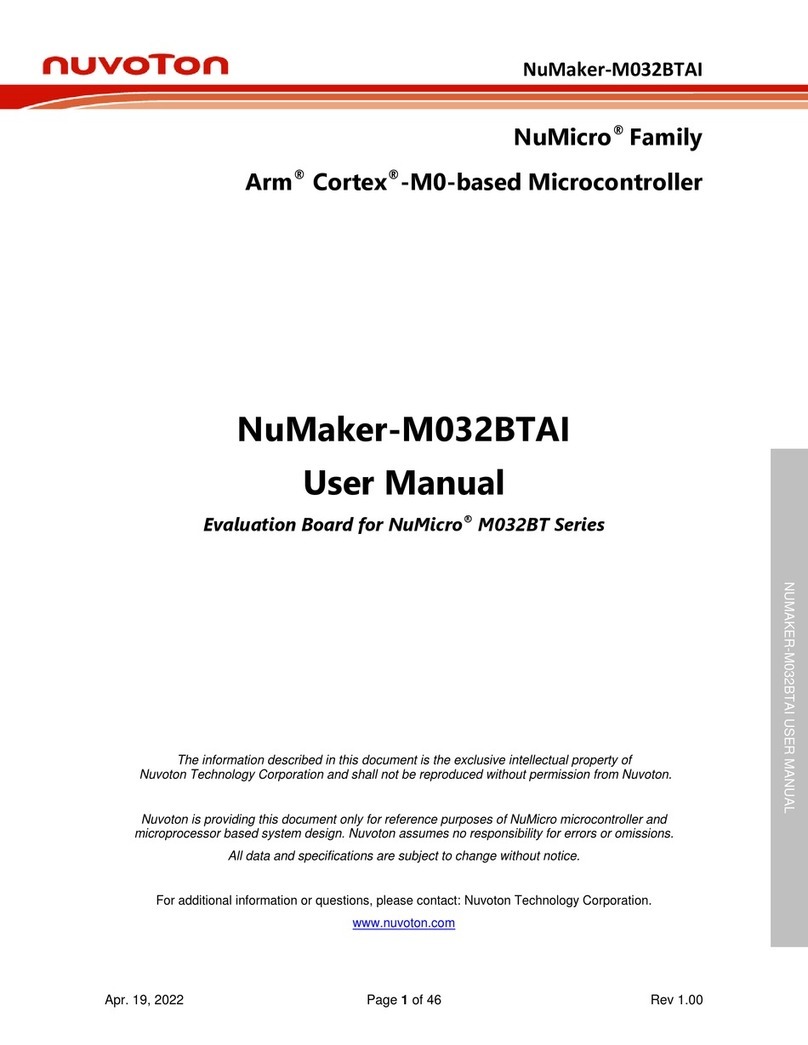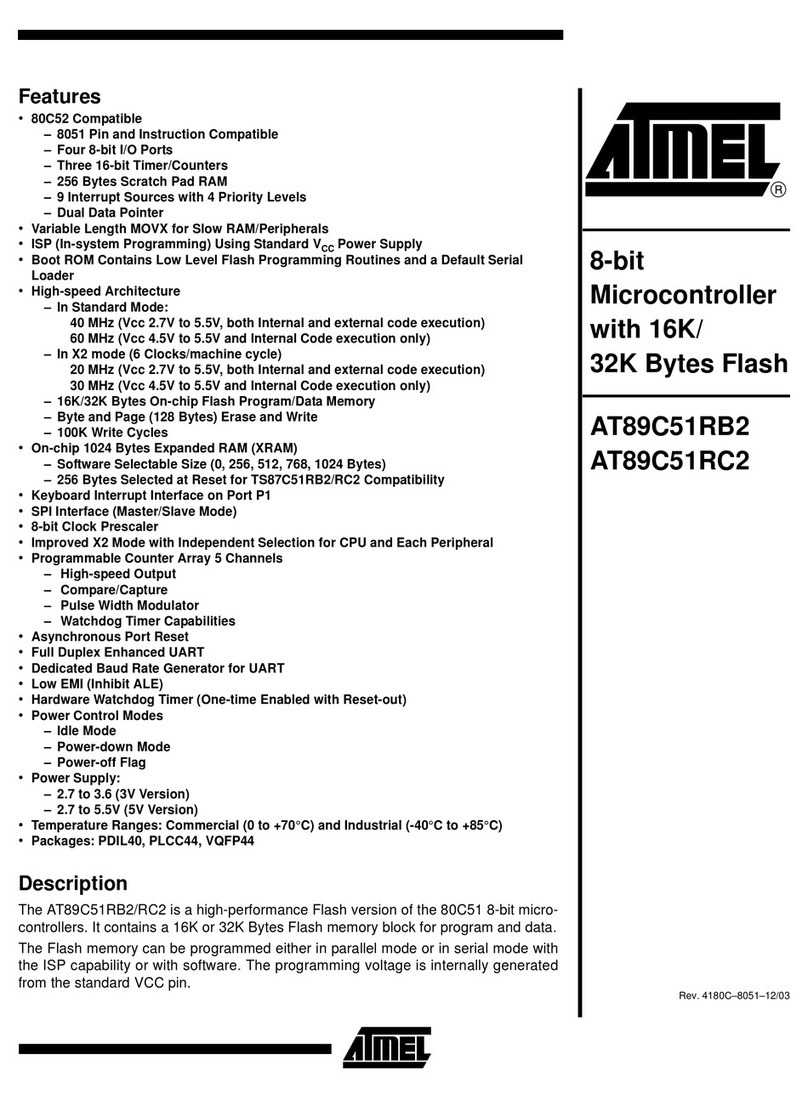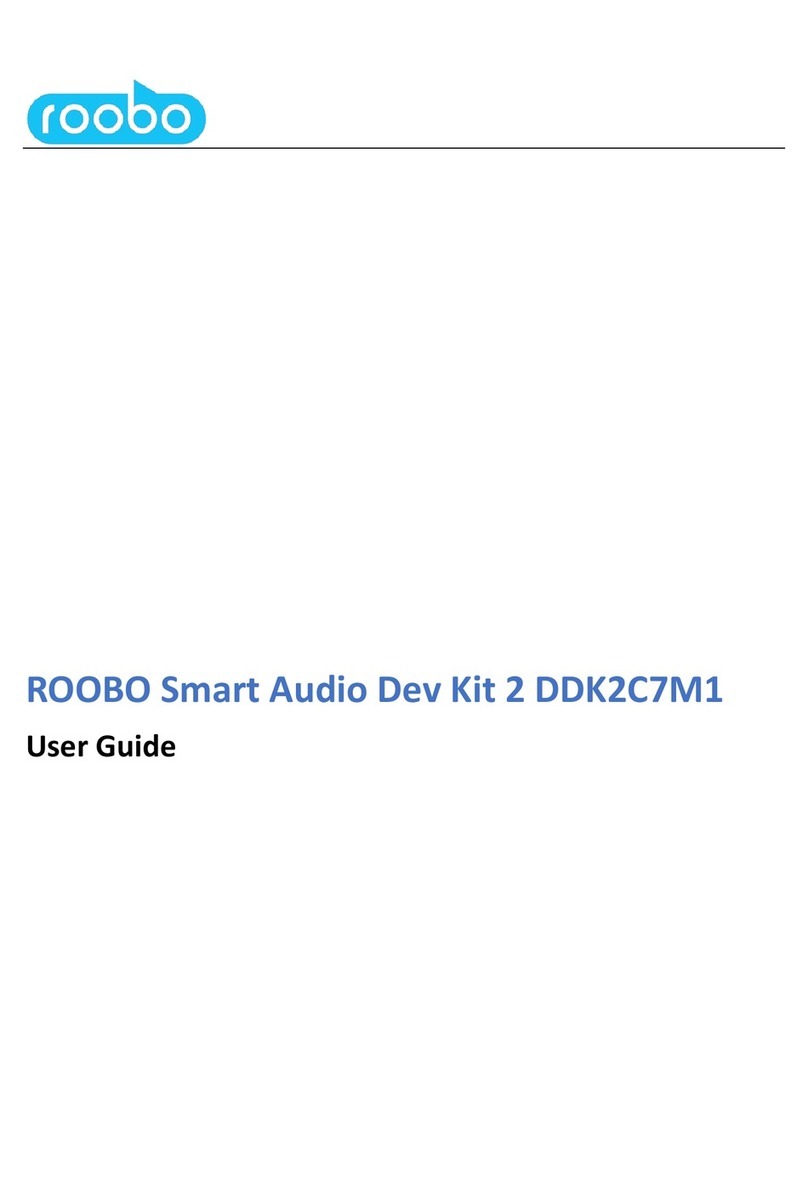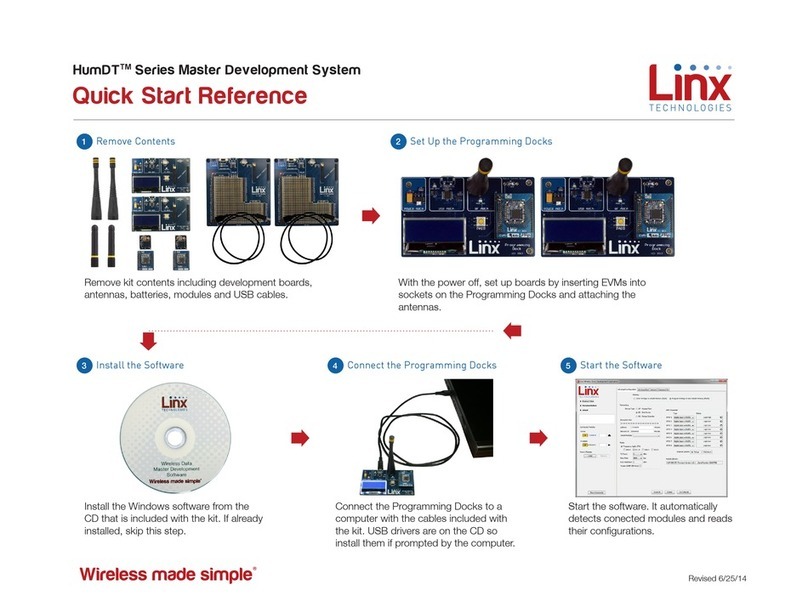bITalino (r)evolution User manual

BITalino (r)evolution User Manual

BITalino (r)evolution
User Manual
PLUX –Wireless Biosignals, S.A.
Av. 5 de Outubro, n. 70 –2.
1050-059 Lisbon, Portugal
http://BITalino.com/
v.1.0
© 2020 PLUX
This information is provided "as is," and we make no express or implied warranties whatsoever with respect to functionality, operability, use, fitness for a
particular purpose, or infringement of rights. We expressly disclaim any liability whatsoever for any direct, indirect, consequential, incidental or special
damages, including, without limitation, lost revenues, lost profits, losses resulting from business interruption or loss of data, regardless of the form of action or
legal theory under which the liability may be asserted, even if advised of the possibility of such damages.
ATTENTION
Please read this User Manual before
using your BITalino (r)evolution device
The information contained in this document has been carefully checked and were made every
effort to ensure its quality. PLUX reserves the right to make changes and improvements to this
manual and products referenced at any time without notice.
The word Bluetooth and its logo are trademarks of Bluetooth SIG Inc. and any use of such
marks is under license. Other trademarks are the property of their respective own.
Please check your systems and sensors after receiving and before using it the first time to
confirm if it contains all the ordered sensors, accessories and other components. Contact our
For regulatory information, please see the Regulatory Disclaimer at the end of this document.

BITalino (r)evolution
User Manual
3 of 30
TABLE OF CONTENTS
List of Figures........................................................................................................................ 4
List of Tables......................................................................................................................... 5
1. General Information....................................................................................................... 6
1.1. General Description.................................................................................................... 6
1.2. Data Acquisition.......................................................................................................... 9
1.3. Technical Specifications ............................................................................................. 9
1.4. Charging Information................................................................................................ 10
1.5. Features................................................................................................................... 10
1.6. Applications.............................................................................................................. 10
1.7. Electrode Connections & Sleeve Color Meanings..................................................... 10
1.8. Physical Characteristics............................................................................................ 11
2. Application Notes ............................................................................................................ 12
2.1. Quick Start Guide..................................................................................................... 12
2.2. Connecting the BITalino devices with sensors and actuators.................................... 14
2.2.1. BITalino (r)evolution Board ................................................................................ 14
2.2.2. BITalino (r)evolution Plugged and Core ............................................................. 15
2.2.3. Assembled BITalino Core .................................................................................. 17
2.3. ECG Signal with BITalino (r)evolution boards........................................................... 19
3. Using the BITalino (r)evolution boards with OpenSignals................................................ 20
3.1. Configuring the Board and Sensor in OpenSignals................................................... 20
3.1.1. OpenSignals (r)evolution (Windows, macOS, Linux).......................................... 20
4. Scientific Publications Using the BITalino Plugged/ Board / Assembled Core.................. 22
5. Safety & Maintenance ..................................................................................................... 23
5.1. Electromagnetic Emissions....................................................................................... 23
5.2. Safety Instructions.................................................................................................... 23
5.3. Transportation and Storage...................................................................................... 26
5.4. Cleaning................................................................................................................... 26
6. Ordering Guides, Regulatory & Legal Information ........................................................... 27
6.1. Ordering Guide......................................................................................................... 27
6.2. Guarantee of Quality & Warranty.............................................................................. 27
6.3. Warranty Voidance................................................................................................... 27
6.4. Contact & Support .................................................................................................... 27
6.5. Regulatory Disclaimer / Intended Use....................................................................... 28

BITalino (r)evolution
User Manual
4 of 30
List of Figures
Figure 1: BITalino Core: BT (left) and BLE/BT (right)............................................................. 6
Figure 2: Assembled BITalino Core BT with 3D casing.......................................................... 6
Figure 3: BITalino Plugged kit BT (black) with BITalino (r)evolution Plugged (green) with Core
BT (turquoise)........................................................................................................................ 7
Figure 4: BITalino Plugged kit BT: Components of the “Core” and sensors........................... 7
Figure 5: BITalino Plugged kit BLE/BT: Components of the “Core” and sensors.................... 8
Figure 6: BITalino Board kit BT: Components of the Board with sensors and “Core”. ............ 8
Figure 7: BITalino Board kit BLE/BT: Components of the Board with sensors and “Core”. .... 9
Figure 8 Physical characteristics of the BITalino Core (BT)................................................. 11
Figure 9: Physical characteristics of the BITalino Board...................................................... 11
Figure 10: BITalino (r)evolution Board with pre-connected sensors and actuators. Sensor ports
for connection to an electrode cable marked in red. ............................................................ 14
Figure 11: Setup for the BITalino Board kit and electrode cables (red) and battery connection
(blue)................................................................................................................................... 15
Figure 12: BITalino (r)evolution Plugged and Core connection ports for sensors and actuators.
Sensors for connection to an electrode cable marked in red................................................ 15
Figure 13: Setup for the BITalino Plugged kit and Core with Cables and Sensors (red) and
battery connection (blue). The markers on the back of the sensor for correct alignment is
marked in green. ................................................................................................................. 16
Figure 14: Assembled BITalino Core with connection ports A1-A6 for the sensors (assembled)
marked in green. ................................................................................................................. 17
Figure 15: ECG acquisition: Assembled Core (left), Plugged/Core (middle), and Board (right)
with electrodes positioned on the collar bones (IN+/-) and reference (REF) on the iliac crest
for Einthoven Lead I. ........................................................................................................... 19
Figure 16: Sample ECG Signal acquired with BITalino (r)evolution assembled core and
assembled ECG sensor at the collar bones (IN+/-) and the iliac crest (REF)....................... 19
Figure 17: Access the OpenSignals (r)evolution device manager........................................ 20
Figure 18: Enabling the device for acquisition. .................................................................... 20
Figure 19: Set the sensor type of the channel you have your sensor connected to.............. 21
Figure 20: Start the acquisition whenever you’re ready. ...................................................... 21

BITalino (r)evolution
User Manual
5 of 30
List of Tables
Table 1: Cables for connecting the BITalino boards to the sensors and / or electrodes....... 10
Table 2: Sleeve color meanings for UC-E6 connection........................................................ 10
Table 3: Sensors and electrode cable combinations............................................................ 14
Table 4: Sensors and electrode cable combinations............................................................ 16
Table 5: Assembled Sensors for the BITalino Assembled Core........................................... 17
Table 6: Electromagnetic emissions. The device is suitable for use in all establishments,
including domestic and those directly connected to low-voltage energy public network supply
which supplies buildings used for domestic purposes.......................................................... 23

BITalino (r)evolution
User Manual
6 of 30
1. General Information
1.1. General Description
The BITalino (r)evolution boards “Board” and “Plugged” both contain the main part, the “Core”
board.
It is built in the “Board” and comes as a separate part in the “Plugged”version. All boards are
available with Bluetooth (BT) or Bluetooth low energy (BLE) / BT dual mode for data transfer.
A) BITalino (r)evolution Core
The BITalino hub “Core” is available as a separate part for do it yourself experiments,
assembled with a 3D-casing or as part of the Plugged or Board.
BITalino (r)evolution Core BT and Core BLE (see
a) Figure 1)
Figure 1: BITalino Core: BT (left) and BLE/BT (right).
b) BITalino (r)evolution Assembled Core
The Assembled Core comes already setup with battery and a 3D printed casing for easy
handling (see Figure 2).
Micro USB charging port

BITalino (r)evolution
User Manual
7 of 30
Figure 2: Assembled BITalino Core BT with 3D casing.
B) BITalino (r)evolution Plugged
The BITalino (r)evolution Plugged comes with the Core plus sensors and actuators (see
Figure 3). Actuators are namely the Light Emitting Diode (LED) and the Buzzer (BUZ). The
sensors are namely Electrodermal Activity (EDA), Electrocardiography (ECG),
Electromyography (EMG), Electroencephalography (EEG), Light (LUX), Pushbutton (BTN)
and the Accelerometer (ACC). It is available as a kit with all accessories needed for an
experimental setup such as battery, cables, and electrodes.
Figure 3: BITalino Plugged kit BT (black) with BITalino (r)evolution Plugged (green) with Core BT (turquoise).

BITalino (r)evolution
User Manual
8 of 30
a) BITalino (r)evolution Plugged BT (see Figure 4)
Figure 4: BITalino Plugged kit BT: Components of the “Core” and sensors.
b) BITalino (r)evolution Plugged BLE / BT dual mode (see Figure 5)
Figure 5: BITalino Plugged kit BLE/BT: Components of the “Core” and sensors.
C) BITalino (r)evolution Board

BITalino (r)evolution
User Manual
9 of 30
The BITalino Board has all sensors and actuators mechanically attached with the Core. It
is also available as a kit with all needed accessories for an experimental setup such as the
Plugged kit.
a) BITalino (r)evolution Board kit BT (see Figure 6)
Figure 6: BITalino Board kit BT: Components of the Board with sensors and “Core”.
b) BITalino (r)evolution Board kit BLE/BT dual mode (see Figure 7)
Figure 7: BITalino Board kit BLE/BT: Components of the Board with sensors and “Core”.

BITalino (r)evolution
User Manual
10 of 30
1.2. Data Acquisition
Together with our available add-ons for our OpenSignals (r)evolution software, one can easily
extract statistical temporal and spectral parameters for further analysis of the acquired sensor
data.
1.3. Technical Specifications
See the details below to learn more about the technical specification of BITalino (r)evolution
Board. For more information regarding the technical specifications of the Microcontroller
(MCU) and Bluetooth module (BT) please download the datasheets here & here / here,
respectively.
> Communication
Bluetooth 2.0 + EDR or Bluetooth 4.1 BLE
> Resolution
10-bit (A1-A4) + 6-bit (A5&A6)
> Digital Ports
2 INPUT (1-bit) + 2 OUTPUT (1-bit), CMOS 3.3V compatible
> Sensors
EMG; ECG; EDA; EEG; ACC; LUX; BTN
For a full list of available and compatible sensors, please visit the BITalino store.
> Actuators
LED; BUZ
> Battery
700 mA 3.7V LiPo (rechargeable)
> Operating Voltage
3.3V
> Input Voltage Range
3.0-5.5V
> Sampling Frequency
1, 10, 100 or 1000Hz
> Analog Sensor Ports
4 in (10-bit) + 2 in (6-bit) + 1 auxiliary in (battery) + 1 out (8-bit)
> Size
65mm x 108mm x 2mm (Board); 65mm x 56mm x 2mm (Core)
> Consumption
~ 65mA
1.4. Charging Information
The micro-USB port is ONLY USED for battery charging. BEFORE OPERATING BITalino
disconnect the charging cable.
> Charging Port
> Input
Micro USB (female)
5VDC with a maximum consumption of 400mA
1.5. Features
>Small form factor
> Raw data output
>Easy-to-use
1.6. Applications
> Life sciences studies
>Biofeedback
> Biomedical device prototyping
>Human-Computer Interaction
1.7. Electrode Connections & Sleeve Color Meanings
The BITalino boards and sensors must be connected to open wire cables and / or electrode
cables (see Table 1), to connect electrodes, sensors and the board.
Table 1: Cables for connecting the BITalino boards to the sensors and / or electrodes.
Sensor Cable
1-lead electrode
cable
2-lead electrode
cable
3-lead electrode
cable

BITalino (r)evolution
User Manual
12 of 30
1.8. Physical Characteristics
The BITalino Core comes in a size of 65mm x 56mm x 2 mm (see Figure 8).
Figure 8 Physical characteristics of the BITalino Core (BT).
The BITalino Board comes in a size of 65mm x 108m x 2mm (see Figure 9).
Figure 9: Physical characteristics of the BITalino Board.

BITalino (r)evolution
User Manual
13 of 30
2. Application Notes
2.1. Quick Start Guide

BITalino (r)evolution
User Manual
14 of 30

BITalino (r)evolution
User Manual
15 of 30
2.2. Connecting the BITalino devices with sensors and actuators
2.2.1. BITalino (r)evolution Board
The BITalino (r)evolution Board comes with sensors and actuators attached to it (see
Figure 10). The sensors EEG, EDA, ECG, and EMG need to be attached to an electrode cable
using the sensor port (marked in red).
Figure 10: BITalino (r)evolution Board with pre-connected sensors and actuators. Sensor ports for connection to
an electrode cable marked in red.
The correct electrode cable (2-/3-lead) can be found in Table 3 and the setup in Figure
11Figure 13.
Table 3: Sensors and electrode cable combinations.
Sensor
2-lead
3-lead
Additional info
ECG
x
EDA
x
EMG
x
EEG
x

BITalino (r)evolution
User Manual
16 of 30
Figure 11: Setup for the BITalino Board kit and electrode cables (red) and battery connection (blue).
2.2.2. BITalino (r)evolution Plugged and Core
The BITalino (r)evolution Plugged and Core can be connected to individual sensors such as
ECG, EMG, EEG, EDA, ACC and LUX using the analogue ports A1-A6 (see Figure 12). All
parts can be connected to the board using a sensor cable (see Figure 12 lower right). The
sensor BTN can be connected to the port I1/I2.
The actuators such as LED and BUZ can be connected to O1/O2 and the digital-to-analogue
converter (DAC) to pulse width modulation (PWM). Sensors for connection to an electrode
cable marked in red.
Figure 12: BITalino (r)evolution Plugged and Core connection ports for sensors and actuators. Sensors for
connection to an electrode cable marked in red.

BITalino (r)evolution
User Manual
17 of 30
Additional sensors such as Electrooculography (EOG) and Electrogastrography (EGG) are
also available for connection to an analog port. For a full list of available and compatible
sensors, please visit the BITalino store.
The correct electrode cable (2-/3-lead) can be found in Table 4 and the setup in Figure 13 with
markers on the back of the sensor for correct alignment marked in green, sensor and cable
alignment marked in red and battery connection marked in blue.
Table 4: Sensors and electrode cable combinations.
Sensor
2-lead
3-lead
Additional info
ECG
x
EDA
x
EMG
x
x
2-lead + 1-lead
(REF)
EEG
x
Figure 13: Setup for the BITalino Plugged kit and Core with Cables and Sensors (red) and battery connection
(blue). The markers on the back of the sensor for correct alignment is marked in green.

BITalino (r)evolution
User Manual
18 of 30
2.2.3. Assembled BITalino Core
The assembled Core can be connected to the available assembled sensors which are listed
in Table 5. The connection ports are the same as for the Core and Plugged. The analogue
ports (marked in green, see Figure 14) are for the connection to the sensors, namely EMG,
EDA, ECG, EEG, ACC-Z, ACC-XYZ, EOG, EGG, BTN, LUX, Respiration (RIP),
Photoplethysmography (PPG), High Definition Temperature (TMP), and FlexiForce (FSR).
Figure 14: Assembled BITalino Core with connection ports A1-A6 for the sensors (assembled) marked in green.
Table 5: Assembled Sensors for the BITalino Assembled Core.
EMG
EDA
ECG
EEG
ACC- Z
ACC-XYZ
EOG
EGG

BITalino (r)evolution
User Manual
19 of 30
BTN
LUX
RIP
PPG
TMP
FSR

BITalino (r)evolution
User Manual
20 of 30
2.3. ECG Signal with BITalino (r)evolution boards
Figure 15 shows the application of the ECG sensor in combination with the Assembled Core
(left), the Plugged (middle), and the Board (right). The two measuring electrodes (IN +/-) were
placed on the collar bones and the reference electrode on the iliac crest to receive the signal
of the Einthoven LeadI. Please see the ECG Sensor Datasheet for more information regarding
the ECG signal.
Figure 15: ECG acquisition: Assembled Core (left), Plugged/Core (middle), and Board (right) with electrodes
positioned on the collar bones (IN+/-) and reference (REF) on the iliac crest for Einthoven Lead I.
An example ECG Signal from the assembled sensor and the assembled Core is illustrated in
Figure 16.
Figure 16: Sample ECG Signal acquired with BITalino (r)evolution assembled core and assembled ECG sensor at
the collar bones (IN+/-) and the iliac crest (REF).
Table of contents
Popular Microcontroller manuals by other brands
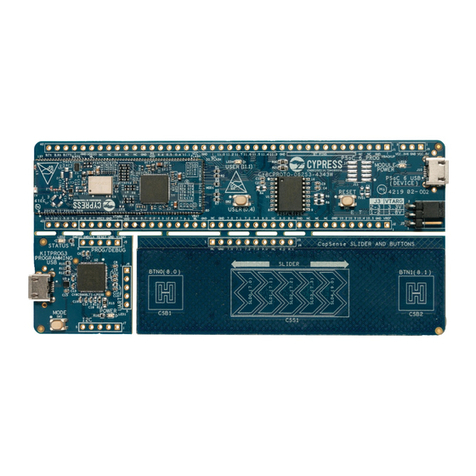
Cypress
Cypress CY8CPROTO-062S3-4343W quick start guide
NXP Semiconductors
NXP Semiconductors MPC5606BK Reference manual
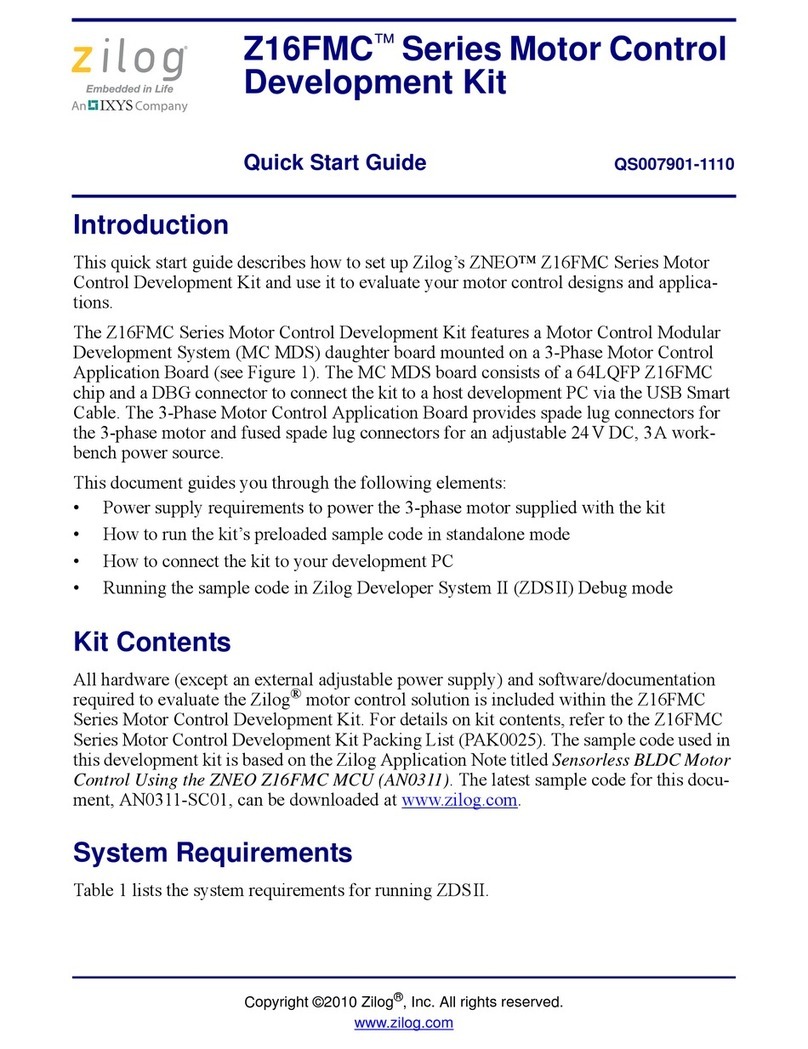
ZiLOG
ZiLOG Z16FMC Series quick start guide

Toshiba
Toshiba TLCS-870/C1 Series manual

NEC
NEC 78K0/Fx2 user manual
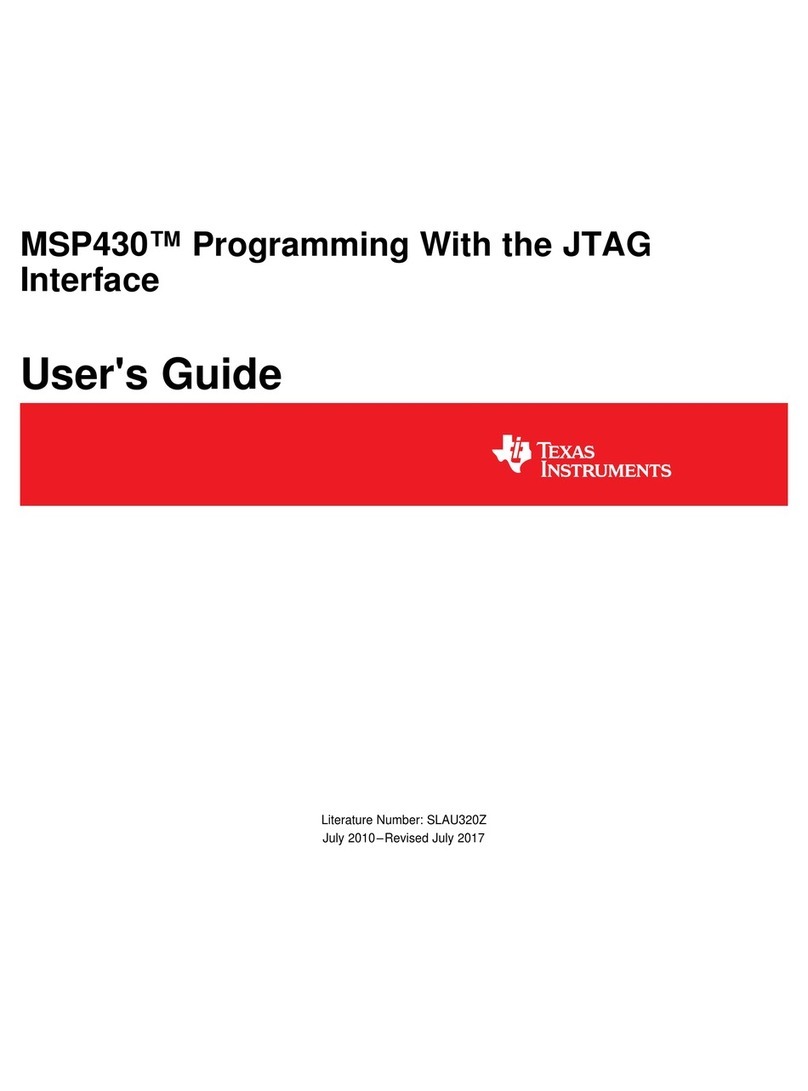
Texas Instruments
Texas Instruments Serial Programming Adapter MSP430 user guide
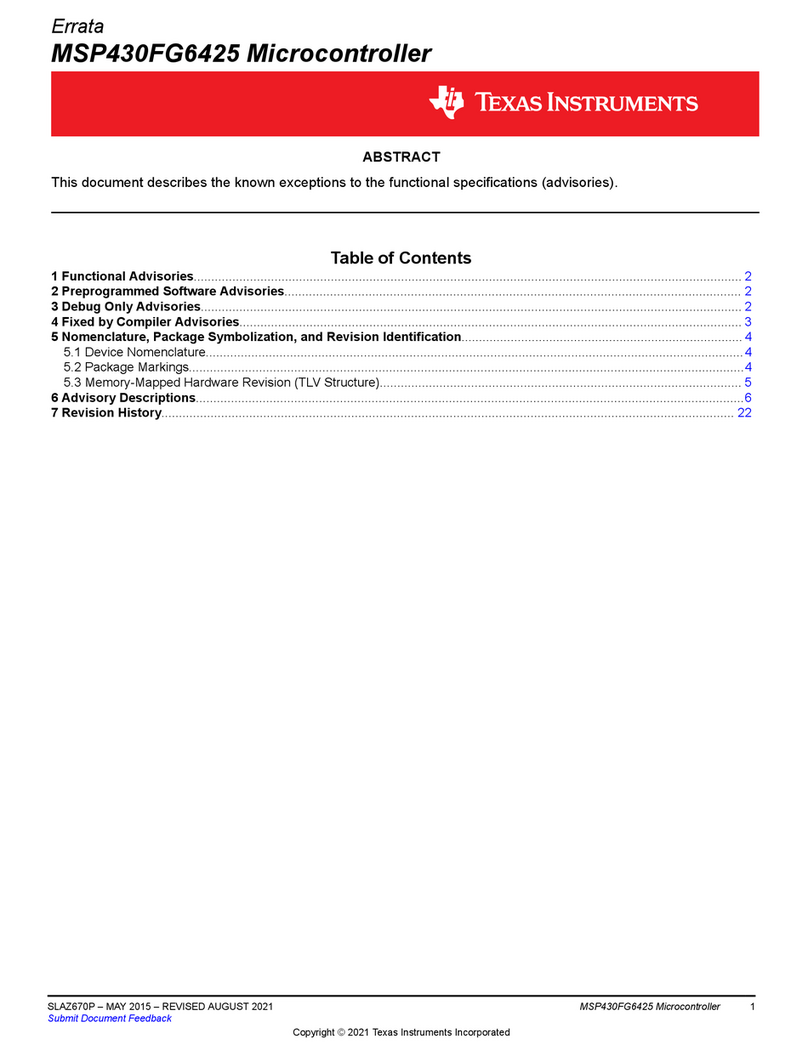
Texas Instruments
Texas Instruments MSP430FG6425 manual
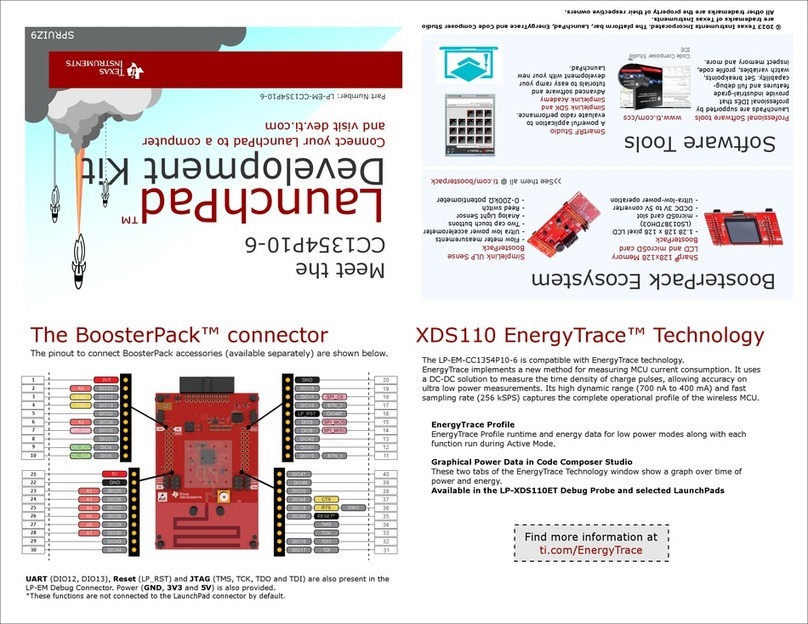
Texas Instruments
Texas Instruments LaunchPad CC1354P10-6 quick start guide
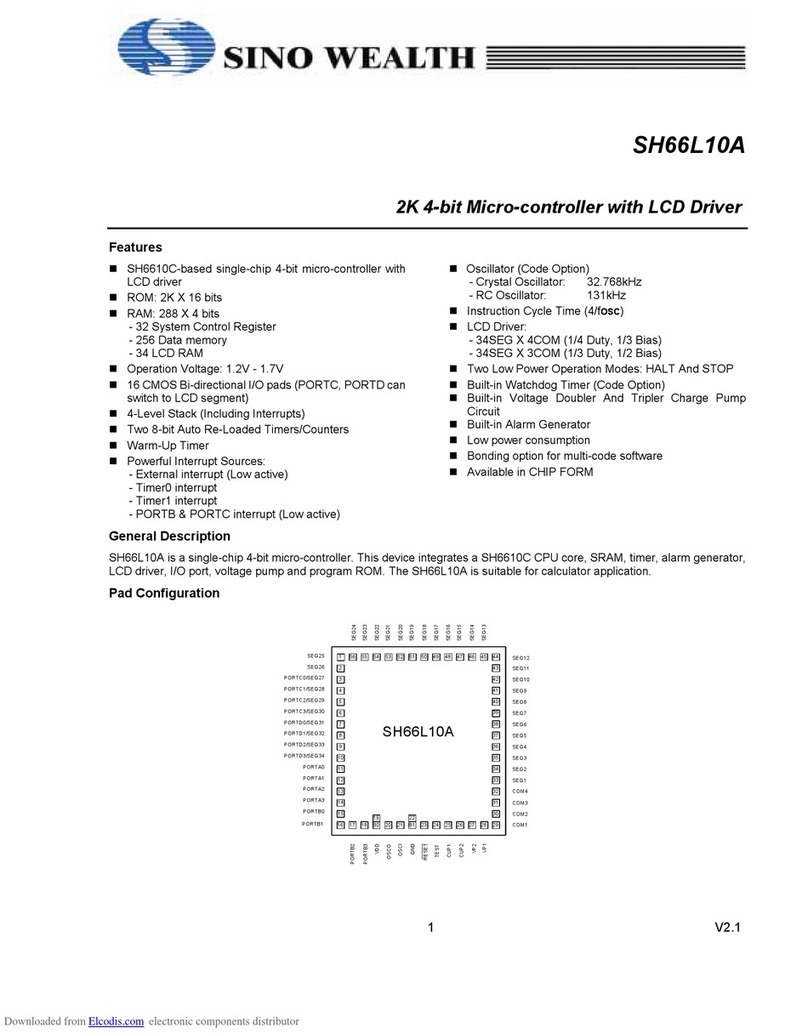
Sino Wealth
Sino Wealth SH66L10A manual

NEC
NEC MuPD78F0132H user manual

Achronix
Achronix Speedster7t 7t1500 user guide
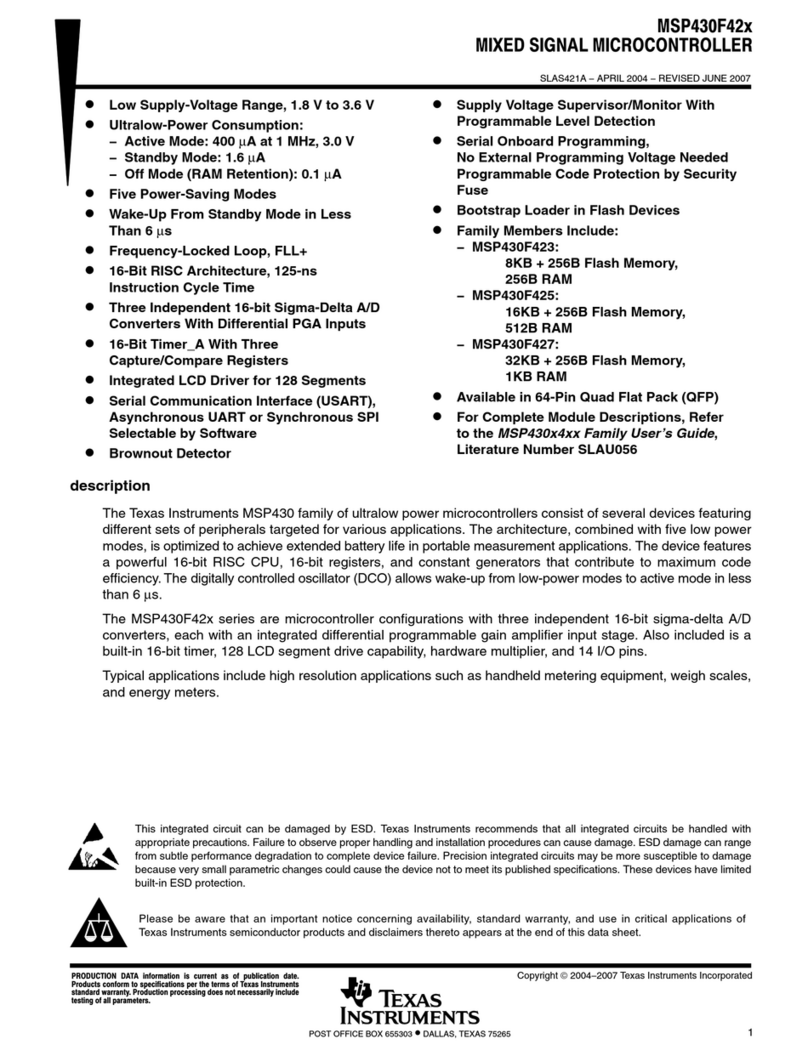
Texas Instruments
Texas Instruments MSP430F42 series instruction manual

